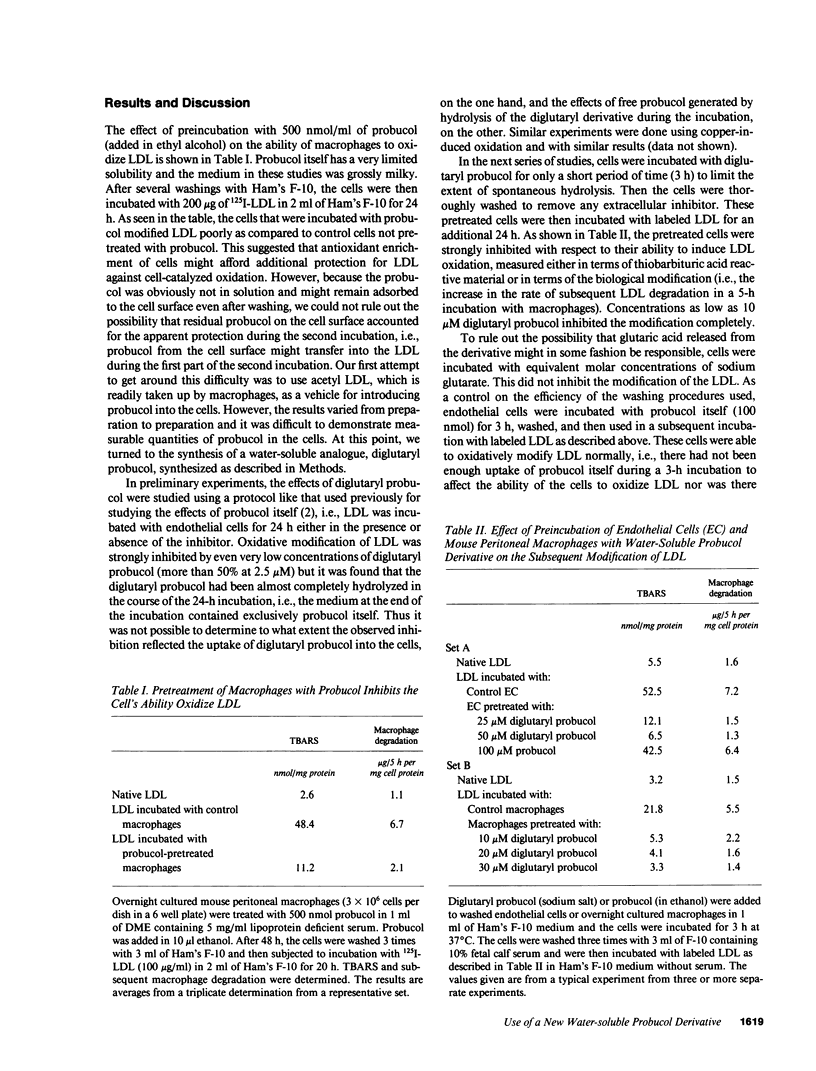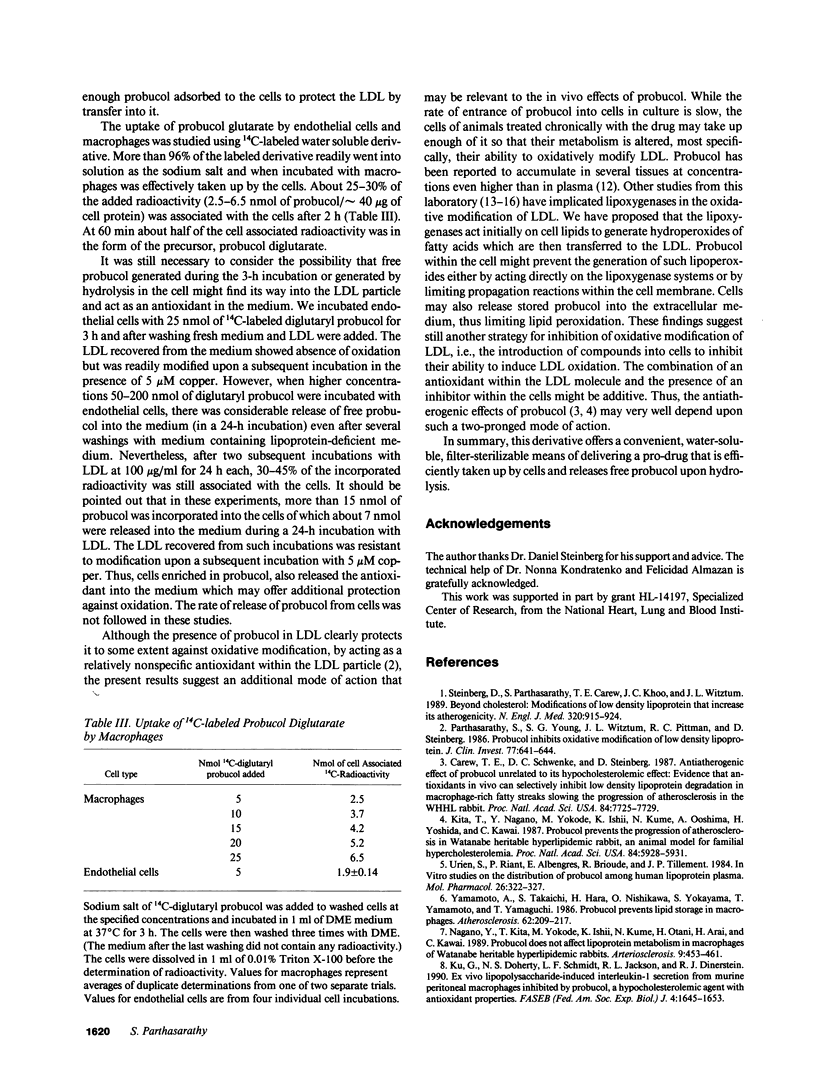Abstract
Oxidative modification of low density lipoprotein (LDL) renders it more atherogenic. Probucol, a highly nonpolar antioxidant, is transported in lipoproteins, including LDL, and inhibits oxidative modification of LDL in vitro. The ability of probucol to inhibit atherogenesis in the LDL receptor-deficient rabbit has been attributed to its antioxidant effect. We report synthesis of a new water-soluble analogue of probucol that is very effective in preventing cell-induced LDL oxidation. The polar probucol derivative, diglutaryl probucol, is efficiently taken up by endothelial cells and macrophages in culture and is hydrolyzed to release the active antioxidant, probucol. The treated cells, after thorough washing, show a marked decrease in their capacity to oxidize LDL during a subsequent incubation. At high concentrations of the derivative, the cells also released free probucol into the medium. Thus, the effectiveness of probucol in vivo may be related both to its presence in LDL, acting as a nonspecific antioxidant, and to an additional ability to inhibit cell-mediated oxidation of LDL by virtue of its uptake into cells.
Full text
PDF



Selected References
These references are in PubMed. This may not be the complete list of references from this article.
- Buckley M. M., Goa K. L., Price A. H., Brogden R. N. Probucol. A reappraisal of its pharmacological properties and therapeutic use in hypercholesterolaemia. Drugs. 1989 Jun;37(6):761–800. doi: 10.2165/00003495-198937060-00002. [DOI] [PubMed] [Google Scholar]
- Carew T. E., Schwenke D. C., Steinberg D. Antiatherogenic effect of probucol unrelated to its hypocholesterolemic effect: evidence that antioxidants in vivo can selectively inhibit low density lipoprotein degradation in macrophage-rich fatty streaks and slow the progression of atherosclerosis in the Watanabe heritable hyperlipidemic rabbit. Proc Natl Acad Sci U S A. 1987 Nov;84(21):7725–7729. doi: 10.1073/pnas.84.21.7725. [DOI] [PMC free article] [PubMed] [Google Scholar]
- Kita T., Nagano Y., Yokode M., Ishii K., Kume N., Ooshima A., Yoshida H., Kawai C. Probucol prevents the progression of atherosclerosis in Watanabe heritable hyperlipidemic rabbit, an animal model for familial hypercholesterolemia. Proc Natl Acad Sci U S A. 1987 Aug;84(16):5928–5931. doi: 10.1073/pnas.84.16.5928. [DOI] [PMC free article] [PubMed] [Google Scholar]
- Ku G., Doherty N. S., Schmidt L. F., Jackson R. L., Dinerstein R. J. Ex vivo lipopolysaccharide-induced interleukin-1 secretion from murine peritoneal macrophages inhibited by probucol, a hypocholesterolemic agent with antioxidant properties. FASEB J. 1990 Apr 1;4(6):1645–1653. doi: 10.1096/fasebj.4.6.2318380. [DOI] [PubMed] [Google Scholar]
- Kuzuya M., Naito M., Funaki C., Hayashi T., Asai K., Kuzuya F. Probucol prevents oxidative injury to endothelial cells. J Lipid Res. 1991 Feb;32(2):197–204. [PubMed] [Google Scholar]
- Nagano Y., Kita T., Yokode M., Ishii K., Kume N., Otani H., Arai H., Kawai C. Probucol does not affect lipoprotein metabolism in macrophages of Watanabe heritable hyperlipidemic rabbits. Arteriosclerosis. 1989 Jul-Aug;9(4):453–461. doi: 10.1161/01.atv.9.4.453. [DOI] [PubMed] [Google Scholar]
- Parthasarathy S., Printz D. J., Boyd D., Joy L., Steinberg D. Macrophage oxidation of low density lipoprotein generates a modified form recognized by the scavenger receptor. Arteriosclerosis. 1986 Sep-Oct;6(5):505–510. doi: 10.1161/01.atv.6.5.505. [DOI] [PubMed] [Google Scholar]
- Parthasarathy S., Wieland E., Steinberg D. A role for endothelial cell lipoxygenase in the oxidative modification of low density lipoprotein. Proc Natl Acad Sci U S A. 1989 Feb;86(3):1046–1050. doi: 10.1073/pnas.86.3.1046. [DOI] [PMC free article] [PubMed] [Google Scholar]
- Parthasarathy S., Young S. G., Witztum J. L., Pittman R. C., Steinberg D. Probucol inhibits oxidative modification of low density lipoprotein. J Clin Invest. 1986 Feb;77(2):641–644. doi: 10.1172/JCI112349. [DOI] [PMC free article] [PubMed] [Google Scholar]
- Rankin S. M., Parthasarathy S., Steinberg D. Evidence for a dominant role of lipoxygenase(s) in the oxidation of LDL by mouse peritoneal macrophages. J Lipid Res. 1991 Mar;32(3):449–456. [PubMed] [Google Scholar]
- Sparrow C. P., Parthasarathy S., Steinberg D. Enzymatic modification of low density lipoprotein by purified lipoxygenase plus phospholipase A2 mimics cell-mediated oxidative modification. J Lipid Res. 1988 Jun;29(6):745–753. [PubMed] [Google Scholar]
- Steinberg D., Parthasarathy S., Carew T. E., Khoo J. C., Witztum J. L. Beyond cholesterol. Modifications of low-density lipoprotein that increase its atherogenicity. N Engl J Med. 1989 Apr 6;320(14):915–924. doi: 10.1056/NEJM198904063201407. [DOI] [PubMed] [Google Scholar]
- Steinbrecher U. P., Parthasarathy S., Leake D. S., Witztum J. L., Steinberg D. Modification of low density lipoprotein by endothelial cells involves lipid peroxidation and degradation of low density lipoprotein phospholipids. Proc Natl Acad Sci U S A. 1984 Jun;81(12):3883–3887. doi: 10.1073/pnas.81.12.3883. [DOI] [PMC free article] [PubMed] [Google Scholar]
- Urien S., Riant P., Albengres E., Brioude R., Tillement J. P. In vitro studies on the distribution of probucol among human plasma lipoproteins. Mol Pharmacol. 1984 Sep;26(2):322–327. [PubMed] [Google Scholar]
- Yamamoto A., Takaichi S., Hara H., Nishikawa O., Yokoyama S., Yamamura T., Yamaguchi T. Probucol prevents lipid storage in macrophages. Atherosclerosis. 1986 Dec;62(3):209–217. doi: 10.1016/0021-9150(86)90095-x. [DOI] [PubMed] [Google Scholar]
- Ylä-Herttuala S., Rosenfeld M. E., Parthasarathy S., Glass C. K., Sigal E., Witztum J. L., Steinberg D. Colocalization of 15-lipoxygenase mRNA and protein with epitopes of oxidized low density lipoprotein in macrophage-rich areas of atherosclerotic lesions. Proc Natl Acad Sci U S A. 1990 Sep;87(18):6959–6963. doi: 10.1073/pnas.87.18.6959. [DOI] [PMC free article] [PubMed] [Google Scholar]


